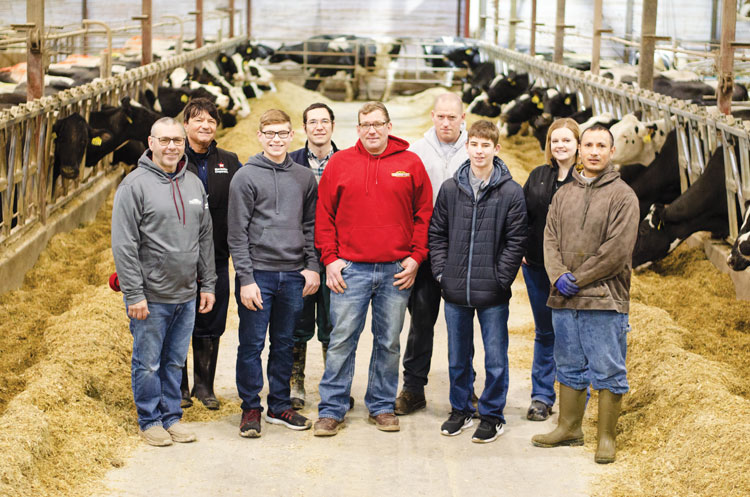
To maintain healthy teat ends, we monitor vacuum levels at 11.9 to 12.2 inches at the teat end,” said Andy Fisher of Reedsville, Wis., “Each year, we evaluate the milking unit takeoff settings for wetness and dryness, and we try to keep reattachments to a minimal level of 0% to 1%. We also graph units quarterly,” continued the dairyman whose farm was one of six herds to win this year’s National Dairy Quality Awards from the National Mastitis Council.
“We use 1% iodine teat dips with six-way emollient and 10%-plus conditioners,” he said. “After washing teats, employees are trained to flip the towel to clean the teat ends,” continued the Wisconsin dairyman who is really committed to producing quality milk. “Clean, dry towels are provided weekly by a towel service. LED lights provide bright, white light for better visibility while prepping cows. Lastly, we strive to keep cows calm while in the holding area and during milking to ensure proper milk let-down.”
All six of this year’s Platinum winners of the National Mastitis Council’s awards share additional insight in this Hoard’s Dairyman Intel as well as the Round Table found on pages 59 to 63 of the January 25, 2021, issue of Hoard’s Dairyman. This year’s competition drew 115 nominations.
Here are additional responses to the question, “How do you maintain healthy teats?”
Blue Star, Middleton, Wis.: We hold monthly meetings to review proper teat dipping. We also regularly check and maintain our equipment.
Christop Farms, Shiocton, Wis.: We believe our pre- and postdips play an important role. Also, a consistent milking routine; proper vacuum levels; and display data on milk machines showing that the unit is in working order proves important. Lastly, inflations are changed and routine maintenance is performed on schedule.
Country Aire, Greenleaf, Wis.: Teats are foamed with predip after stripping and then dried off with a cloth towel. After milking is completed, teat ends are dipped in iodine. Any milk cows with a teat injury are immediately moved to the hospital barn for extra attention.
UW Marshfield, Stratford, Wis.: Milk units have a setting threshold for automatic takeoff (ATO) flow rate to prevent overmilking, teat end damage, and hyperkeratosis. Liners are changed routinely. Cold weather dip containing emollient and 1% disinfectant help condition teats during extreme cold months. We strategically cull cows with poor udder and/or teat conformation. We also cull unusually slow milkers.
Wilson Centennial Dairy, Carson City, Mich.: The automatic takeoffs and vacuum levels are charted quarterly by Robert’s Dairy Service, our equipment dealer. Inflations are changed every three weeks in our 40-stall herringbone parlor. We installed new pulsators this past spring. We also emphasize having clean, dry teat ends prior to attaching the milking unit and good postdip coverage before the cows leave the parlor.
Hoard’s Dairyman is honored to co-sponsor the National Dairy Quality Awards with the National Mastitis Council. The program is possible thanks to sponsorship from Boehringer Ingelheim, Cargill, Conewango, Ecolab, GEA, and IBA.








